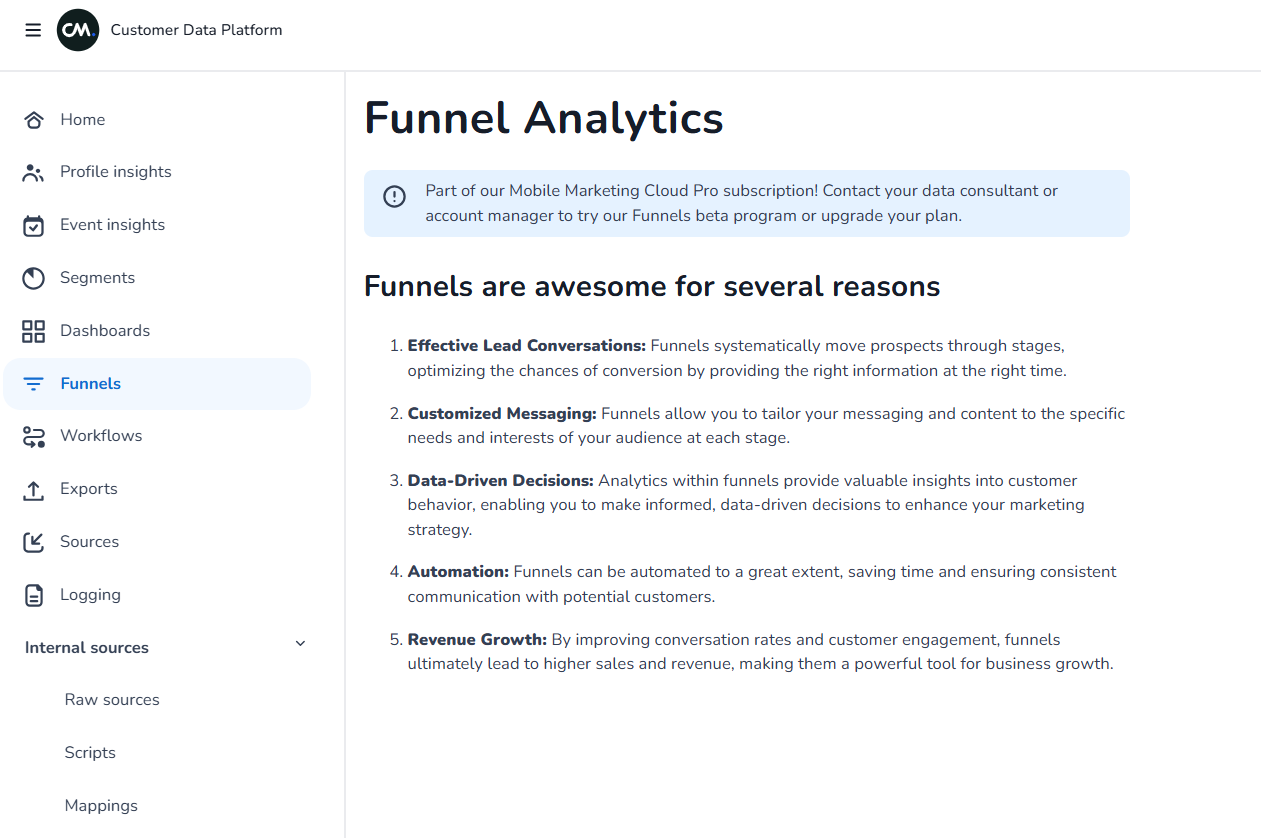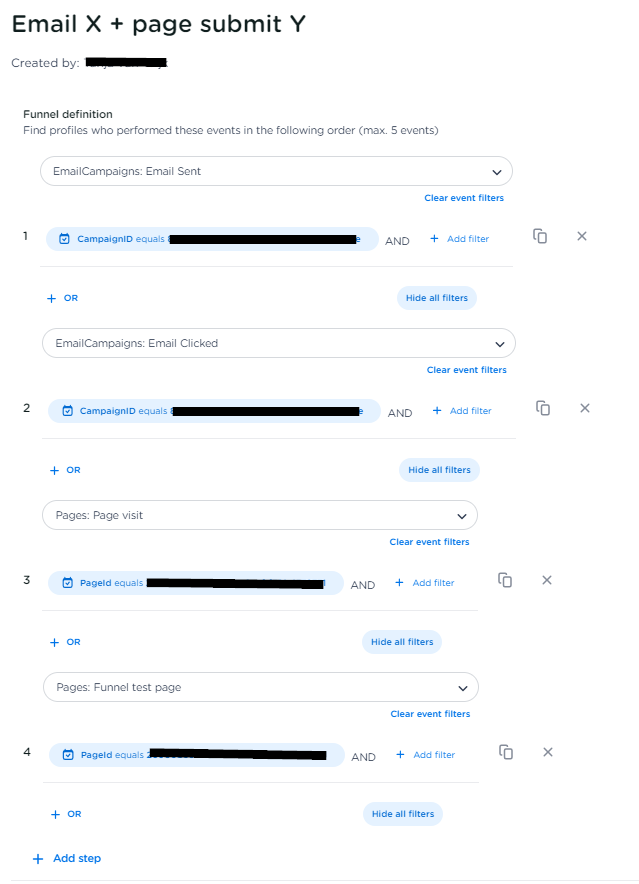Understanding Funnels in the CDP
Introduction
Funnels are a powerful tool in marketing analytics, enabling businesses to visualize and optimize the user journey from initial engagement to conversion. This article provides an overview of funnels, their benefits, and how to set them up effectively within your marketing software suite.
What Are Funnels?
Funnel analytics is a method of tracking and analyzing the steps users take on a website or digital platform. It visualizes the user journey, starting from the first interaction and progressing toward a desired outcome, such as a purchase, sign-up, or form submission. By identifying drop-off points, businesses can optimize the user experience to maximize conversions and achieve specific goals.
Pre-Requisites
Before you can start using funnels, ensure the following requirements are met:
Subscription: A Mobile Marketing Cloud Pro subscription is required.
BigQuery Integration: Currently, this integration must be requested through the Product team.
Step Limitations: A maximum of 5 steps can be defined per funnel.
Funnel Limitations: A maximum of 8 funnels can be created per account.

Why Use Funnels?
Funnels provide a clear, visual representation of the user journey, offering insights that can drive meaningful improvements in your marketing strategy. Here’s why they are essential:
Identify Drop-Off Points: Funnels highlight specific stages where users abandon the process, enabling businesses to address pain points and improve the user experience.
Data-Driven Decisions: By analyzing user behavior at each step, businesses can make informed decisions to optimize conversion rates.
Channel Effectiveness: Funnels help assess the performance of various marketing channels, identifying which ones drive valuable traffic and which need improvement.
Real-Time Insights: Near real-time data allows businesses to respond quickly to trends and make timely adjustments.
Revenue Growth: By improving conversion rates and customer engagement, funnels contribute to higher sales and overall business growth.
Key Benefits of Funnel Analytics
Effective Lead Conversion: Funnels guide prospects through the conversion process, delivering the right information at the right time to maximize success.
Customized Messaging: Tailor your content and messaging to meet the specific needs of users at each stage of the funnel.
Automation: Automate repetitive tasks within the funnel to save time and ensure consistent communication with potential customers.
Optimization Opportunities: Pinpoint bottlenecks and areas for improvement, such as confusing UI or lengthy forms, to enhance the user experience.
What Are You Analyzing?
Before creating a funnel, it’s important to define your objectives and understand the user journey. Follow these steps:
Define Your Goals: Clearly outline the desired outcome, such as a purchase, newsletter sign-up, or form submission.
Identify Key Steps: Break down the process into distinct steps, such as visiting a website, viewing a product, adding it to the cart, and completing the purchase.
Track User Behavior: Monitor where users drop off in the process.
Analyze and Identify Issues: Use data to pinpoint bottlenecks, such as slow loading times or confusing navigation.
Optimize the Funnel: Make data-driven changes to improve the user experience, such as simplifying forms or enhancing content.
Measure Marketing Effectiveness: Run A/B tests to validate the impact of your changes and refine your funnel based on the results.
Monitor and Adjust: Continuously monitor your funnel and adapt to changing user behavior and market trends.
Pro Tip: Funnel analysis is an ongoing process. Regularly review and refine your funnels to maintain optimal performance.
How to Set Up a Funnel
Access the Funnel Overview Page: This page provides a list of all your funnels, along with details on who last modified them. From here, you can create a new funnel, analyze an existing one, or make adjustments.

Define Events: Select the events you want to analyze in sequential order. Use the "Refine Event By" button to filter events for more granular analysis.
Set Steps: Add up to 5 steps in each funnel. A minimum of 2 steps is required to save the funnel.
Save and Analyze: Once your funnel is set up, save it and begin analyzing the data.

Example Funnel Setup
Let’s say you want to analyze the performance of an email campaign. Here’s how you could set up your funnel:
Step 1: Profiles targeted with a specific email campaign.
Step 2: Users who clicked on the email.
Step 3: Users who visited the landing page linked in the email.
Step 4: Users who submitted the form on the landing page.

The resulting funnel chart will display the drop-off rate at each step and the overall conversion rate. For example, if 33.33% of your initially targeted audience submitted the form, this metric will be clearly visualized in the chart.

Below the funnel chart, you’ll find:
Summary: A high-level overview of the funnel’s performance.
Step Breakdown: Detailed metrics for each step, helping you identify specific areas for improvement.

Conclusion
Funnels are an indispensable tool for businesses looking to optimize their marketing efforts and improve conversion rates. By providing a clear visualization of the user journey, they enable data-driven decision-making and continuous improvement. With the ability to track, analyze, and refine each step of the process, funnels empower businesses to achieve their goals and drive revenue growth.
Start leveraging funnel analytics today to unlock the full potential of your marketing strategy!
